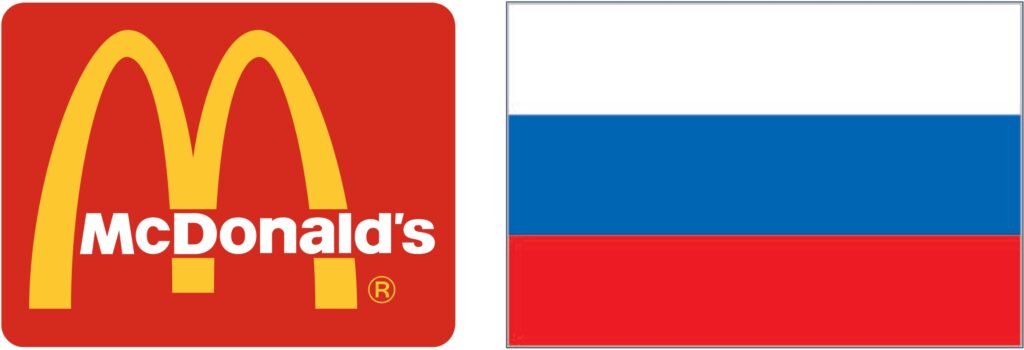By Joanna Seddon
Managing Partner
Pulling out of Russia will increase the value of Western brands in Russia because it will restore their scarcity value and reignite the appeal they have lost in recent years.
Putin’s invasion of Ukraine creates powerful political reasons for Western brands to pull out of Russia. In the age of Brand Purpose, staying open creates a major risk to brand reputation, revenues across the rest of the world.
Brands from Apple and Microsoft, to Hermes and LVMH, to H&M and Nike, Ford, GM, and Toyota have stopped selling to Russia. Ikea has shut its stores. Entertainment brands Disney, Sony, Paramount, and Live Nation have canceled film launches and rock tours. Oil companies such as BP and Sell are selling their stakes in Russian joint ventures. You can no longer stay in a Russian AirBnB. Google and Facebook pulled back their operations and have now, anyway, been banned.
But some brands, and some of the world’s biggest brands, have not. You can still eat a hamburger at MacDonalds, or a pizza at Pizza Hut, drink Coca-Cola, go to a Starbucks and shop for Oreos and Frito-Lay. Why? These are brands with a larger (though still small) percentage of their sales coming from Russia. They are hoping that if they keep quiet and sit tight, this will all go away. It won’t. Putin isn’t going to give up that easily.
What these lagging companies need to recognize is that pulling out of Russia will not only increase the value of their brands in the rest of the world, it will also increase their brand value in Russia.
This isn’t because most Russians disapprove of the war in Ukraine. The majority of Russians are behind Putin and in favor of the ‘military intervention’. Due to the harsh curtailing of the media and social media, the only narrative most ordinary Russians have access to, is the story spun by the Kremlin. They only know what Putin tells them.
Russians love Western brands, and especially American brands. There are good reasons, going back over 100 years. From the Russian Revolution in 1917, to the collapse of the Soviet Union in 1991, Western brands were unavailable in stores. The Soviet government was focused on building up heavy industry and paid scant attention to producing acceptable substitutes. Consumer goods were at the lowest end of generic—poor quality, badly designed and of course, unbranded, not marketed. Pictures of Soviet leaders and exhortations to work harder and cultivate a communist spirit replaced gaily colored ads on buildings. It made daily life boring.
Naturally, because Western brands were unobtainable, Russian consumers yearned for them. A huge illicit trade arose in smuggling goods in from Western Europe. Students from African countries, who, unlike Soviet citizens, could travel abroad easily, financed lavish lifestyles through shopping train trips to Germany and France. Levis and Marlboro became alternative currencies. Western brands were put on a pedestal. Anything Western was better, and the more expensive the better.
When the Soviet Union fell, all this changed. At first, Russians rushed to buy the prized western brands they couldn’t get before. Many stories have been told about the opening of MacDonalds in Pushkinsky Square in Moscow in 1990. 30,000 people turned up. Lines stretched for blocks. You had to pay bribes to get in. MacDonalds and Coca-Cola enjoyed a quite different status in Russia from the US. They were luxury brands. Ikea, based in an unattractive chemical town outside Moscow, became a center of pilgrimage, despite the two hours or more on public transport it took to get there.
But during decades of high oil prices, Russians grew richer. Western brands became more affordable, easier to obtain. All Russian apartments seemed to be outfitted from Ikea. Everyone was drinking Coca-Cola, rather than Baikal (the excellent Russian alternative). As they became taken for granted, the appeal of Western brands diminished. It was replaced by a growing pride in things Russian, and nostalgia for a romanticized Soviet past. Old Russian brands such as Stolichnaya vodka were revived, sought after, and widely counterfeited. New Russian brands, especially tech brands such as Yandex gained greater appeal and far more users than Google Maps or Uber. Uber recently threw in the towel and turned management of its Russian operation over to Yandex (and is now selling all of it).
Pulling out of Russia will increase the value of Western brands in Russia because it will restore their scarcity value. They will regain their exotic allure, become luxuries again, be more sought after, and command a price premium. As awareness of the war grows and economic conditions worsen, MacDonalds and Coca-Cola have a chance once again to be seen as beacons of progress and desire.
… March 8: Belated congratulations to McDonald’s!
McDonald’s has just seen the light and is closing its restaurants in Russia. It is a little late. We’ve been doing research on GenZ and trust and one clear finding is – to retain and build trust and brand value, it’s better to act fast. Nike knows this. So does LVMH. So does Canada Goose. But what it also shows, is that GenZ is very forgiving. If a brand not only apologizes for mistakes, but follows through and takes concrete action to make things right, this can actually increase trust and value.
